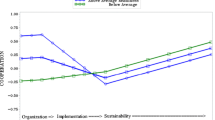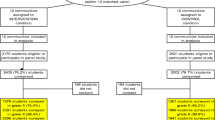Abstract
This study examined the longitudinal predictors of quality of functioning of community prevention teams during the “operations” phase of team development. The 14 community teams were involved in a randomized-trial of a university-community partnership project, PROSPER (Spoth et al., Prevention Science, 5(1): 31–39, 2004b), that implements evidence-based interventions intended to support positive youth development and reduce early substance use, as well as other problem behaviors. The study included a multi-informant approach to measurement of constructs, and included data from 137 team members, 59 human service agency directors and school administrators, 16 school principals, and 8 Prevention Coordinators (i.e. technical assistance providers). We examined how community demographics and social capital, team level characteristics, and team member attributes and attitudes are related to local team functioning across an 18-month period. Findings indicate that community demographics (poverty), social capital, team member attitudes towards prevention, and team members’ views of the acceptability of teen alcohol use played a substantial role in predicting various indicators of the quality of team functioning 18 months later.
Similar content being viewed by others
Notes
Although one could draw distinctions, we utilize the terms coalitions, partnerships, and local teams interchangeably in this manuscript. These terms in our usage refer to a range of informal through formal collaborative groups formed to enact positive change in a community.
One community did not have any Agency Directors participate in the interview at wave 1.
The Pennsylvania School District achievement data was collected from the Pennsylvania System of School Assessment District Report Cards (2003). The Iowa School District achievement data was collected directly from the participating school district offices.
We estimated the AD community collaboration value with a multivariate OLS regression for the one community that did not have any Agency Directors participate in the interview.
Technical reports for each measure by each respondent are available from the first author.
Results for all regressions can be obtained from the first author.
References
Arthur, M. W., Hawkins, D. J., Catalano, R. F., & Olson, J. J. (1998). Diffusion project: Fall 1998 community key informant interview. Seattle: University of Washington, Social Development Research Group.
Backer, T. E. (2003). Evaluating community collaborations (vol. 158). New York, NY: Springer.
Bronfenbrenner, U. (1986). Ecology of the family as a context for human development: Research perspectives. Developmental Psychology, 22(6), 723–742.
Butterfoss, F. D., Goodman, R. M., & Wandersman, A. (1996). Community coalitions for prevention and health promotion: Factors predicting satisfaction, participation, and planning. Health Education Quarterly, 23(1), 65–79.
Chavis, D. M. (1995). Building community capacity to prevent violence through coalitions and partnerships. Journal of Health Care for the Poor and Underserved, 6(2), 234–245.
Chavis, D., Florin, P., & Felix, M. R. J. (1992). Nurturing grassroots initiatives for community development: The role of enabling systems. In T. Mizrahi & J. Morrison (Eds.), Community organization and social administration: Advances, trends, and emerging principles. Binghamton, NY: Haworth.
Chilenski-Meyer, S. E., Greenberg, M. T., & Feinberg, M. (2007). Community readiness as a multi-dimensional construct. Journal of Community Psychology, 35, 351–369.
Chinman, M. J., Imm, P., & Wandersman, A. (2004). Getting to Outcomes 2004: Promoting accountability through methods and tools for planning, implementation, and evaluation. Santa Monica, CA: RAND Corporation Technical Report.
COMMIT. (1995). Community intervention trial for smoking cessation (COMMIT): I. Cohort results from a four-year community intervention. American Journal of Public Health, 85(2), 183–192.
Emshoff, J., Blakely, C., Gray, D., Jakes, S., Brounstein, P., Coulter, J., et al. (2003). An ESID case study at the federal level. American Journal of Community Psychology, 32, 345–357.
Feinberg, M. E., Greenberg, M. T., & Osgood, D. W. (2004a). Readiness, functioning, and perceived effectiveness of community prevention coalitions: A study of Communities That Care. American Journal of Community Psychology, 33, 163–176.
Feinberg, M. E., Greenberg, M. T., & Osgood, D. W. (2004b). Technical assistance in prevention programs: Correlates of perceived need in Communities That Care. Evaluation and Program Planning, 27, 263–274.
Feinberg, M. E., Greenberg, M. T., Osgood, D. W., Anderson, A., & Babinski, L. (2002). The effects of training community leaders in prevention science: Communities That Care in Pennsylvania. Evaluation and Program Planning, 25, 245–259.
Feinberg, M. E., Greenberg, M. T., Osgood, W. O., & Sartorius, J. S. (2005). Can community coalitions have a population level impact on adolescent behavior problems? CTC in Pennsylvania.
Florin, P., Mitchell, R., & Stevenson, J. (1993). Identifying training and technical assistance needs in community coalitions: A developmental approach. Health Education Research, 8(3), 417–432.
Florin, P., Mitchell, R., Stevenson, J., & Klein, I. (2000). Predicting intermediate outcomes for prevention coalitions: A developmental perspective. Evaluation and Program Planning, 23, 341–346.
Foster-Fishman, P. G., Berkowitz, S. L., Lounsbury, D. W., Jacobson, S., & Allen, N. A. (2001). Building collaborative capacity in community coalitions: A review and integrative framework. American Journal of Community Psychology, 29(2), 241–261.
Gottlieb, N. H., Brink, S. G., & Gingiss, P. L. (1993). Correlates of coalition effectiveness: The Smoke Free Class of 2000 Program. Health Education Research, 8(3), 375–384.
Green, L. W., & Kreuter, M. W. (2002). Fighting back or fighting themselves? Community coalitions against substance abuse and their use of best practices. American Journal of Preventive Medicine, 23(4), 303–306.
Greenberg, M. T., Chilenski-Meyer, S., & Feinberg, M. E. (2007). Community and team member factors that influence the early phase functioning of community prevention teams: The PROSPER project. Journal of Primary Prevention (in press).
Hallfors, D., Hyunsan, C., Livert, D., & Kadushin, C. (2002). Fighting back against substance abuse: Are community coalitions winning? American Journal of Preventive Medicine, 23, 237–245.
Hawkins, J. D., Catalano, R. F., & Arthur, M. W. (2002). Promoting science-based prevention in communities. Addictive Behaviors. Special Issue: Integration substance abuse treatment and prevention in the community, 27(6), 951–976.
Herrenkohl, T. I., Maguin, E., Hill, K. G., Hawkins, J. D., Abbott, R. D., & Catalano, R. F. (2000). Developmental risk factors for youth violence. Journal of Adolescent Health, 26(3), 176–186.
Jausa, G. K., Chou, C., Bernstein, K., Wang, E., McClure, M., & Pentz, M. A. (2005). Using structural characteristics of community coalitions to predict progress in adopting evidence based programs. Evaluation and Program Planning, 28, 173–184.
Kegler, M. C., Steckler, A., McLeroy, K., & Malek, S. H. (1998). Factors that contribute to effective community health promotion coalitions: A study of 10 Project ASSIST Coalitions in North Carolina. Health Education and Behavior, 25(3), 338–353.
Kerr, N. L., & Tindale, R. S. (2004). Group performance and decision making. Annual Review of Psychology, 55, 623–655.
Klerman, L. V., Santelli, J. S., & Klein, J. D. (2005). So what have we learned? The editors’ comments on the coalition approach to teen pregnancy. Journal of Adolescent Health, 37, S115–S118.
Kreuter, M. W., Lezin, N. A., & Young, L. A. (2000). Evaluating community-based collaborative mechanisms: Implications for practitioners. Health Promotion Practice, 1(1), 49–63.
Livit, M., Wandersman, A. (2004). Organizational functioning: Facilitating effective interventions and increasing the odds of program success. In D. M. F. a. A. Wandersman (Ed.), Empowerment evaluation principals in practice (pp. 123–142). New York: Guilford.
Moos, R. (1981). Work environment scale. Palo Alto, CA: Consulting Psychologists Press.
O’Donnell, L., Scattergood, P., Alder, M., & San Doval, A. (2000). The role of technical assistance in the replication of effective HIV interventions. AIDS Education and Prevention, 12(Suppl. A), 99–111.
Osgood, D. W., & Chambers, J. M. (2000). Social disorganization outside the metropolis: An analysis of rural youth violence. Criminology, 38(1), 81–115.
Redmond, C., Spoth, R. L., Shin, C., Schainker, L., Greenberg, M., & Feinberg, M. (2007). Proximal outcomes of an evidence-based universal family-focused intervention implemented by community teams. Under review.
Reisig, M. D., & Cancino, J. M. (2004). Incivilities in nonmetropolitan communities: The effects of structural constraints, social conditions, and crime. Journal of Criminal Justice, 32(1), 15–29.
Roussos, S. T., & Fawcett, S. B. (2000a). A review of collaborative partnerships as a strategy for improving community health. Annual Review of Public Health, 21, 369–402.
Roussos, S. T., & Fawcett, S. B. (2000b). A review of collaborative partnerships as a strategy for improving community health. American Review of Public Health, 21, 369–402.
Saxe, L., Reber, E., Hallfors, D., Kadushin, C., Jones, D., Rindskopf, D., et al. (1997). Think globally, act locally: Assessing the impact of community-based substance abuse prevention. Evaluation and Program Planning, 20(3), 357–366.
Spoth, R., Greenberg, M., Bierman, K., & Redmond, C. (2004a). PROSPER community–university partnership model for public education systems: Capacity-building for evidence-based, competence-building prevention. Prevention Science, 5(1), 31–39.
Spoth, R. L., Greenberg, M., Bierman, K., & Redmond, C. (2004b). PROSPER community-university partnership model for public education systems: Capacity-building for evidence-based, competence-building prevention. Prevention Science, 5(1), 31–39.
Spoth, R. L., Redmond, C., Shin, C., Greenberg, M. T., Clair, S., & Feinberg, M. E. (2007). Toward public health benefits from community-university partnerships: PROSPER effectiveness trial results for substance use at 1 1/2 years past baseline. American Journal of Preventive Medicine (in press).
Stevenson, J., & Mitchell, R. (2003). Community level collaboration for substance abuse prevention. American Journal of Community Psychology, 23, 371–404.
Tabachnik, B. G., & Fidell, L. S. (2001). Using multivariate statistics. Boston: Allyn and Bacon.
Wandersman, A., & Florin, P. (2003). Community interventions and effective prevention. American Psychologist. Special Issue: Prevention that works for children and youth, 58(6–7), 441–448.
Wandersman, A., Florin, P., Friedmann, R., & Meier, R. (1987). Who participates, who does not, and why? An analysis of voluntary neighborhood organizations in the United States and Israel. Sociological Forum, 2(3), 534–555.
Wandersman, A., Valois, R. F., Ochs, L., de la Cruz, D. S., Adkins, E., & Goodman, R. M. (1996). Toward a social ecology of community coalitions. American Journal of Health Promotion, 10(4), 299–307.
Author information
Authors and Affiliations
Corresponding author
Additional information
Work on this paper was supported by research grant DA 013709 from the National Institute on Drug Abuse
Rights and permissions
About this article
Cite this article
Feinberg, M.E., Chilenski, S.M., Greenberg, M.T. et al. Community and Team Member Factors that Influence the Operations Phase of Local Prevention Teams: The PROSPER Project. Prev Sci 8, 214–226 (2007). https://doi.org/10.1007/s11121-007-0069-2
Received:
Accepted:
Published:
Issue Date:
DOI: https://doi.org/10.1007/s11121-007-0069-2




